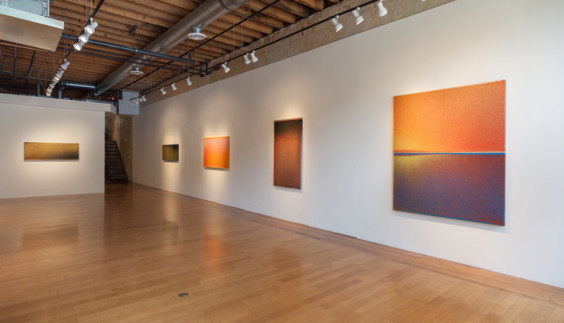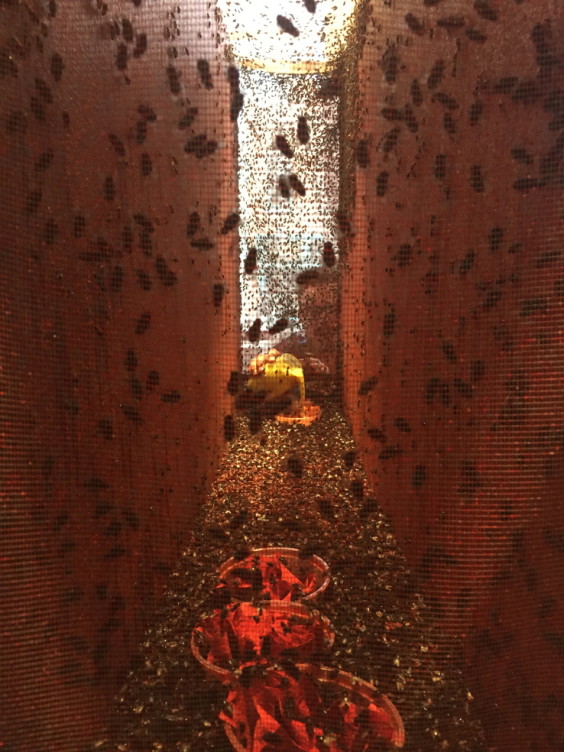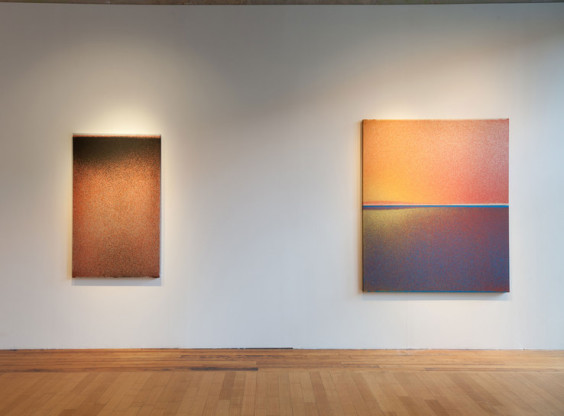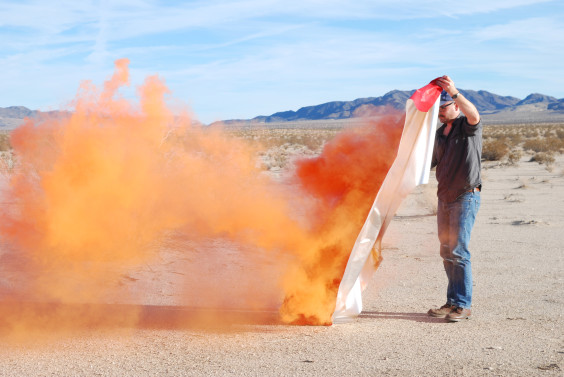
by Mark Molloy

John Knuth is an artist based in Los Angeles, California whose work includes sculpture, photography, and painting. He is perhaps most known for his fly paintings, in which he raises flies on a diet of sugar and paint and then lets them digest it onto a canvas, resulting in colorful speckled abstract paintings. Knuth was born and raised in Minnesota and moved to Chicago after graduating from the University of Minnesota in 2001.
A few words by the artist about his time in Chicago:
“I always loved Chicago. It was the bigger more exciting city. At that time, the Chicago music scene and experimental music scene was booming. I loved bands like US Maple, Joan of Arc, Tortoise, Kevin Drumm etc.. and was really excited about the weirdo noise and jazz scene, and would go to the Empty Bottle on Tuesdays for the Ken Vandermark’s residency he was doing there with people like Fred Lomberg-Holm and Kent Kessler.
“I left Chicago for Los Angeles because of the call of the west and because the idea of a manifest destiny is an overwhelming siren song.” – John Knuth
Alessandra Stamper: How did you develop an interest in common houseflies and when did you first recognize their collaborative potential?
John Knuth: I like that you used the words “collaborative potential.” I think of the flies as a labor force. It is an interesting idea – a collaboration vs. me restricting their life to achieve a desired outcome. The flies are just doing what flies usually do. They eat and regurgitate. Each of the little specs of paint is called a flyspeck. Flyspecks are everywhere. I often see them on kitchen windows.

For the very first paintings I did with flies in 2005 I was feeding them McDonalds and Taco Bell. I was interested in their nastiness as creatures and them being a metaphor for the megalopolis. I wanted to create an intense environment where the filth of the inhabitants is amplified because of their sheer density. The color of the early paintings was shades of brown.
The early paintings were really inspiring to me in the way that I realized I was making the flies do something outside of their nature. Flies are non-social insects. Social insects are ants and bees where they work together for their own survival. I soon moved onto feeding them paint and made them do something truly outside their nature. Similar to the city of Los Angeles. If you put a million people or a million flies in a tight space something transcendent happens.
AS: Your fly paintings have been compared to the pointillism present in Impressionist art, specifically in the work of Georges Seurat. How do you feel about this comparison?
JK: I’ll take it.

AS: How do you know when you’re done with one of the fly paintings? How do you reach that point of looking at it and think, “Yes, I think enough flies have defecated on this canvas”?
JK: The compositions and colors are very specific. For the show Powerplant at Brand New Gallery in Milan, the color pallet was based on energy producing colors. I used reds, yellows, blacks, whites and metallics. I thought of the canvases as places where energy is produced. I paired them with these tall skinny paintings made with melted space blanket material stretched over mirrored Plexiglas. Those paintings are about different reflections of light or heat energy coming back at the viewer. I wanted the show to have a feeling of energy infrastructure.
AS: I know your work has evolved from sculpture, to installation, to photography, to the fly paintings, and now to the smoke-flare paintings. How do you see yourself evolving next?
JK: Much of my work is exploring materials or ideas in different forms. An example is the emergency smoke flare. I have used these as singular actions like lighting them off inside ghost shacks out in the desert. I did this because I wanted to see the smoke fill an abandoned/dead space and give it new temporary life. The smoke filled the space and seeped out the cracks and dispersed across the desert and the life disappeared into the air. I have also taken pictures of them with a flash against the black night sky. With this version, the smoke flare was an abstract space that was hard to define – a transcendent landscape on its own. With the smoke flare paintings I liked that I could use the smoke flare to stain the canvases with a permanent mark but during their making the pigment from the flair also spread and dispersed across the landscape.
Right now I am making sandbag sculptures in the studio and on the beach. I use the same reflective space blanket for the sandbags that I do for paintings. Again it is about using that material as an idea of survivalism and formalism. I am attracted to this material because it reflects the world around it.
AS: You seem to crave dangerous situations to a certain extent through your artistic process. I’m thinking mainly of your smoke-flare paintings and slicing metallic Mylar with a knife. Is there something about these risks that inspires you artistically?
JK: These actions are not particularly dangerous. Slicing and burning are transformational acts, not representations of transformation. It is all quite controlled.

AS: Is there any literature that informs your art? Is there any imagery in literature that has stayed with you?
JK: I recently finished The Snake Charmer by Jamie James. It is the story of Dr. Joe Slowinski who was a very important herpetologist who died on an expedition collecting and studying poisonous snakes in 2001 in Burma of a bite by a Krait – one of the most poisonous snakes in the world.
I also recently finished Kippenberger, The Artist and His Families by Susanne Kippenberger – Susanne wrote the book about her brother German artist Martin Kippenberger who died of liver cancer at the age of 44 due to his love of life and alcohol.
I loved these two books and people they portrayed for their pursuit of life and freedom.
*****
For more on John Knuth’s work, check out this cool video about the process behind the fly paintings!
This interview took place via e-mail September of 2015.
John Knuth “finds beauty at the edge of panic. Made with signal flares, emergency blankets, smoke and fire, his work plays its haunting chords as the Titanic sinks. Though originally from Minnesota, Knuth fits nicely into the disaster mentality of Los Angeles, an earthquake-‐ prone city that seems to delight in picturing itself at the edge of doom.” – Ed Schad, Flash Art 2015.
Knuth received his MFA from USC and a BFA from the University of Minnesota. He has had recent solo exhibitions at Brand New Gallery (Milan, Italy), Marie Kirkegaard Gallery (Copenhagen, Denmark), Human Recourses (Los Angeles, CA,), Andrew Rafacz Gallery (Chicago, IL), and The Armory Center for the Arts (Los Angeles, CA). Knuth lives and works in Los Angeles, California.
Alessandra Stamper received her MA at the University of Chicago where she studied Film and Art History. Her thesis explored the interplay of the gaze of the artist, the artist’s subject, and the camera. She currently lives in Chicago, IL and works as an Intern for MAKE Literary Magazine.















click to see who
MAKE Magazine Publisher MAKE Literary Productions Managing Editor Chamandeep Bains Assistant Managing Editor and Web Editor Kenneth Guay Fiction Editor Kamilah Foreman Nonfiction Editor Jessica Anne Poetry Editor Joel Craig Intercambio Poetry Editor Daniel Borzutzky Intercambio Prose Editor Brenda Lozano Latin American Art Portfolio Editor Alejandro Almanza Pereda Reviews Editor Mark Molloy Portfolio Art Editor Sarah Kramer Creative Director Joshua Hauth, Hauthwares Webmaster Johnathan Crawford Proofreader/Copy Editor Sarah Kramer Associate Fiction Editors LC Fiore, Jim Kourlas, Kerstin Schaars Contributing Editors Kyle Beachy, Steffi Drewes, Katie Geha, Kathleen Rooney Social Media Coordinator Jennifer De Poorter
MAKE Literary Productions, NFP Co-directors, Sarah Dodson and Joel Craig